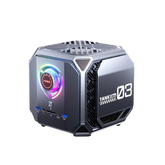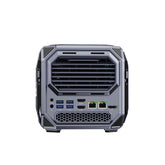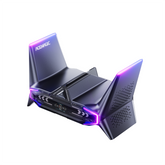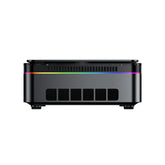Mini PCs vs. Thin Clients: Which Computing Solution Suits Your Needs?

In today's computing landscape, Mini PCs and Thin Clients are becoming increasingly popular, capturing the interest of more and more users. Their compact size, low power consumption, and high efficiency make them ideal for a wide range of applications, including home entertainment, office environments, and industrial control. However, despite appearing similar in some functions and design, significant differences exist between them, often leaving users puzzled.
This article aims to resolve this confusion by diving deep into the distinctions between Mini PCs and Thin Clients, helping you understand their features comprehensively and make more informed decisions when choosing between the two.
Definitions and Overview of Mini PCs and Thin Clients
Introduction to Mini PCs
A Mini PC is an independent personal computing device that offers full computer functionality, albeit in a much smaller package than traditional desktops. Known for its compact and portable nature, a Mini PC is typically the size of a book or the palm of your hand, making it easy to place and move without sacrificing performance.
Typical Mini PC configurations include low-power yet high-efficiency processors such as Intel Core or AMD Ryzen series, sufficient memory (usually ranging from 4GB to 16GB), and storage options like solid-state drives or hard disks. These devices support mainstream operating systems such as Windows, Linux, and in some cases, macOS. They are equipped with a variety of ports, including USB, HDMI or DisplayPort for monitor connection, Ethernet for network connectivity, and audio input-output interfaces to meet diverse peripheral needs.
Mini PCs serve numerous purposes. In home entertainment, they can be the cornerstone of a home theater, supporting high-definition video playback, streaming apps, or light gaming. In office environments, Mini PCs manage daily tasks such as document editing, emails, and web conferencing with ease. They're also capable in multimedia processing sectors, suitable for photo editing and basic video editing tasks. Moreover, due to their small size and low noise, Mini PCs are ideal for space-constrained settings like educational multimedia classrooms, exhibition demo equipment, and industrial automation control.
Introduction to Thin Clients
A Thin Client is a streamlined computing terminal that relies on a server to perform most computing tasks. Its design philosophy centers around offloading complex processing and data storage to a central server, while the Thin Client handles basic input-output operations and simple task executions, resulting in significantly reduced hardware requirements with streamlined and low-power characteristics.
Hardware-wise, Thin Clients typically feature low-performance processors, minimal memory, and minimized storage since most applications and data are server-based. They operate specialized operating systems or firmware optimized for efficient server environment connections, such as those using Windows Server's Remote Desktop Services or Virtual Desktop Infrastructure (VDI) solutions. Thin Clients also support basic peripheral connectivity like keyboards, mice, monitors, and network interfaces to satisfy user interaction needs.
Thin Clients are prevalent in environments demanding centralized management and high security. For example, in large corporations, VDI deployments allow employees to access personalized virtual desktops via Thin Clients, ensuring data remains secure and centralizing management for efficiency. Similarly, in public facilities like libraries, school computer labs, and internet cafés, Thin Clients reduce equipment costs and simplify system maintenance and upgrades. In sectors like healthcare and finance, where high security and unified data management are critical, Thin Clients play a vital role.
Core Functions and Technical Differences

Differences in Hardware Configuration
Mini PCs are typically equipped with high-performance hardware, including powerful processors, larger memory capacity, and ample local storage space. They may feature Intel Core or AMD Ryzen processors, with memory ranging from 8GB to 32GB, and storage solutions like SSDs or HDDs to meet high-speed data retrieval and storage requirements. These configurations empower Mini PCs to independently run various complex applications, such as multimedia editing, 3D modeling, and gaming.
In contrast, Thin Clients are designed to be more streamlined in terms of hardware. They usually feature lower power processors, with less memory and local storage capacity, since the primary computing and storage tasks are managed by a central server. Thin Clients handle input and output processing, such as receiving user commands and displaying server-rendered results. This simplified hardware design gives Thin Clients an edge in cost and power consumption.
In summary, Mini PCs boast robust local computing capabilities suitable for executing tasks independently, while Thin Clients rely on servers for primary processing, making them best suited for network-dependent computing environments.
Operating System Support
Mini PCs offer flexible support for operating systems such as Windows, Linux, and macOS. Users can install and switch between operating systems according to their needs, allowing for a rich software ecosystem and diverse application scenarios. This flexibility makes Mini PCs ideal for personal users, developers, and professionals who require specific OS support.
Thin Clients typically run lightweight operating systems like Thin OS, embedded Linux, or streamlined versions of Windows Embedded, designed specifically for remote connections. These operating systems are optimized for efficient communication with servers and virtual desktop environments, providing a fast and stable remote connection experience. However, the operating systems of Thin Clients are often limited in functionality and cannot locally install or run complex applications.
Thus, Mini PCs have a clear advantage in OS choice and local application execution, while Thin Clients focus on network connectivity and remote services.
Dependence on Network Connectivity
Mini PCs can operate independently in offline environments; their local computing power allows users to perform tasks like document editing, multimedia playback, and offline gaming. While network connections can enhance their capabilities, they are not essential, offering greater flexibility in use cases.
Conversely, Thin Clients are highly dependent on network connectivity. As they mainly function by connecting to a server to access computing resources and data, any network disruption can severely impact their functionality, rendering them unusable at times. Network instability and latency can also directly affect the user experience.
Therefore, reliable network connectivity is critical for Thin Clients, whereas Mini PCs enjoy greater independence and flexibility.
Cost and Power Consumption
The higher hardware specifications of Mini PCs lead to greater purchase and operational costs. High-performance processors, sufficient memory, and high-speed storage devices contribute to their price, and over time, they incur higher power consumption, resulting in increased operational costs.
Due to their streamlined hardware configurations, Thin Clients offer lower purchase costs and power consumption, making them ideal for enterprises or institutions that require large-scale terminal deployment. This low-cost, low-power advantage becomes particularly evident in mass application scenarios. However, it's important to note that Thin Clients require servers to carry out major computing tasks, which entails costs associated with server acquisition, maintenance, and operation.
Overall, while Mini PCs may have higher costs for individual use, they provide superior performance and autonomy; Thin Clients offer cost-effectiveness and energy efficiency, making them suitable for centralized management and large-scale applications.
Comparison of Advantages and Disadvantages of Mini PCs and Thin Clients
Advantages and Disadvantages of Mini PCs
Advantages:
- High Flexibility: Supports multiple operating systems and software, allowing users to install and configure based on their needs.
- Powerful Local Computing Capability: Can independently run complex applications, ideal for multimedia processing, gaming, and professional software.
- Strong Independence: Does not rely on networks or servers, ensuring it can function normally anytime and anywhere.
Disadvantages:
- Higher Cost: High-performance hardware increases purchase and maintenance costs.
- Higher Power Consumption: Compared to streamlined devices, Mini PCs have higher energy consumption and average performance in energy saving.
Example: For users needing to perform video editing or play large-scale games at home, Mini PCs provide necessary performance support but also come with higher equipment and energy costs.
Advantages and Disadvantages of Thin Clients
Advantages:
- Low Power and Cost: Simple hardware configuration saves on procurement and operational expenses, making it ideal for large-scale deployment.
- Centralized Management: All applications and data are server-side, facilitating IT departments in unified updates and maintenance, improving security and efficiency.
Disadvantages:
- High Dependence: Heavily reliant on networks and servers; network issues directly affect usage.
- Limited Functionality: Cannot run high-performance applications locally, limiting personalized configurations.
Example: In a corporate environment that requires unified management of terminal devices, Thin Clients can reduce costs and enhance security. However, if the network is unstable, employee productivity may be affected.
Analysis of Applicable Scenarios

Mini PC Scenarios
With strong local computing power and flexibility, Mini PCs are suitable for a variety of personal and professional applications.
- Home Entertainment: Mini PCs can function as a home multimedia center, connecting to TVs and sound systems to play high-definition movies, music, and photos. They support streaming services like Netflix, YouTube, and various media player software, providing diverse entertainment options. Additionally, Mini PCs can run light games, catering to family entertainment needs.
- Personal Computing: For those who work or study from home, Mini PCs offer full computer functionality, supporting office software, web browsing, email, and video conferencing. Its compact size saves desktop space, suitable for limited home or office areas.
- Multimedia Processing: Photographers, designers, and content creators can use Mini PCs for tasks such as image editing, design drawing, and simple video editing. While Mini PCs might not match the performance of high-end desktops, they sufficiently meet light to moderate multimedia processing needs.
- Mobile Work: Their small size makes Mini PCs easy to carry, ideal for professionals who need to move their office setups between different locations. Paired with a portable monitor and wireless peripherals, they enable a complete work environment anywhere.
Case Study: Zhang, a freelance graphic designer, frequently switches between working at client offices and at home. He opted for a high-performance Mini PC, coupled with a portable monitor and tablet, creating a mobile design workstation that allows him to efficiently complete design tasks anywhere.
Thin Client Scenarios
Due to centralized management, low cost, and high security, Thin Clients are widely used in environments requiring unified device management and data security.
- Enterprise Centralized Management: In large enterprises, IT departments can use Thin Clients to achieve centralized control over all employee terminals. Software updates, permission settings, and security policies can be deployed centrally on servers, reducing maintenance costs and improving management efficiency.
- VDI Deployment: Virtual Desktop Infrastructure (VDI) allows employees using Thin Clients to access personal virtual desktop environments hosted on servers. This enhances flexibility and productivity by allowing access to personalized work desktops and applications from any location with any Thin Client device.
- Educational and Public Facilities: In places like school computer labs, libraries, and training centers, Thin Clients can lower hardware procurement and maintenance costs. Since data and applications are stored on servers, users cannot store personal data on local devices, enhancing system security and stability.
- Healthcare and Finance Industries: These sectors demand high data security and privacy protection. With Thin Clients, all sensitive data resides securely on server environments, reducing the risk of data breaches. Centralized management also facilitates system updates and compliance audits.
Case Study: A hospital opted to deploy Thin Clients throughout its facilities to protect patient privacy and sensitive data. Medical staff access electronic medical records and other healthcare applications through Thin Clients, with all data securely stored on protected servers. This approach not only enhances data security but also reduces the maintenance workload for terminal devices.
User Decision Guide: How to Choose?

When deciding between a Mini PC and a Thin Client, consider the following steps and questions to identify your needs and make the best decision.
Step 1: Define Your Purpose
-
What is your primary usage need?
- Need to run complex local applications (e.g., video editing, 3D modeling, gaming): Choose a Mini PC.
- Primarily use server-based applications or virtual desktops, without the need for high-performance local computing: Choose a Thin Client.
Step 2: Consider Flexibility
-
Do you require the ability to install and configure operating systems and software independently?
- Yes, you need highly personalized settings and software freedom: Choose a Mini PC.
- No, satisfied with a pre-set work environment, without the need to install software yourself: Choose a Thin Client.
Step 3: Assess Network Environment
-
What are your network conditions like?
- Stable and high-speed network ensures continuous connectivity: A Thin Client can work efficiently.
- Unstable network or need to work offline: A Mini PC is more suitable as it does not rely on the network.
Step 4: Evaluate Cost and Scale
-
What is your budget and deployment scale?
- Individual or small scale use with a relatively ample budget: A Mini PC may have higher costs but offers more features and freedom.
- Large-scale deployment with a need to control costs and simplify management: A Thin Client has the advantage with low cost and centralized management.
Step 5: Emphasize Security and Management Needs
-
What are your data security and system management requirements?
- Need high data security, unified system management, and maintenance: Thin Client can meet your centralized management and data security needs.
- Prefer to control data and system independently without many restrictions: Mini PC allows full control over your local system.
Key Consideration Summary:
-
Do you require powerful offline computing capability?
- Yes: Choose a Mini PC.
- No: Choose a Thin Client.
-
Do you need high flexibility for systems and software?
- Yes: Choose a Mini PC.
- No: Choose a Thin Client.
-
Is your network environment reliable?
- Reliable: Thin Client performs well.
- Not reliable: Mini PC is a safer choice.
Targeted Recommendations:
- For individual users, creative workers, and professionals needing high performance and flexibility: Mini PC is your ideal choice.
- For enterprise administrators, educational institutions, and organizations needing centralized management and high security: Thin Client is more suited to your needs.
By following this guide, we hope you can clearly determine which device is more suitable for you based on your specific situation and make an informed choice.
Conclusion and Recommendation
In summary, Mini PCs and Thin Clients exhibit significant differences in core functions, application scenarios, and technical features. Mini PCs, with their strong local computing power and operational flexibility, are suited for personal users and professionals who need to run various applications independently. In contrast, Thin Clients rely on server computing resources, emphasizing centralized management and data security, making them ideal for enterprise and institutional deployment.
If you're considering purchasing a Mini PC, take a look at the ACEMAGIC Mini series products. ACEMAGIC is a renowned Mini PC brand that integrates high-performance hardware, including dedicated graphics cards, into its compact designs, offering users excellent computing performance and multimedia processing capabilities to satisfy both performance and portability needs.






